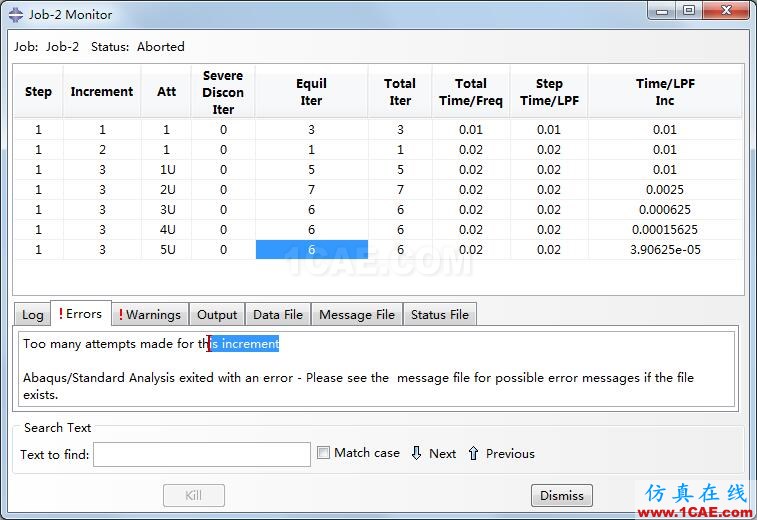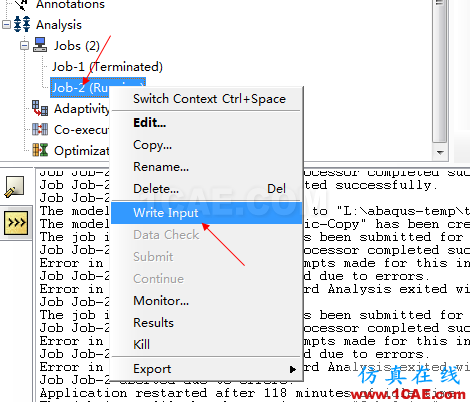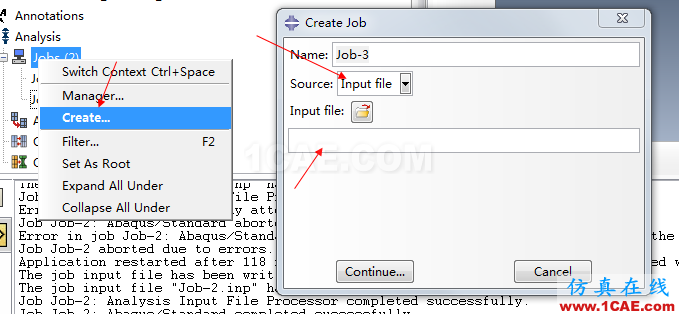abaqus出现Too many attempts made for this increment怎么解决?
2017-06-14 by:CAE仿真在线 来源:互联网
abaqus会进程碰到Too many attempts made for this increment,如下图

Threre may be many factors that you should check. Some of them you might want to check predominantly are,1_Material properties and equivalency of units 2_ Mesh size and type 3_Boundary conditions 4_constraints such as rigid body motion 5_Step size and no of increments Also look in Abaqus documentation for Common problems in convergence of solution.
模拟计算的加载过程包含单个或多个步骤,所以要定义分析步。它一般包含分析过程选择,载荷选择,和输出要求选择。而且每个分析步都可以采用不同的载荷、边界条件、分析过程和输出要求。例如:步骤一:将板材夹于刚性夹具上。步骤二:加载使板材变形。步骤三:确定变形板材的自然频率。增量步是分析步的一部分。在非线性分析中,一个分析步中施加的总载荷被分解为许多小的增量,这样就可以按照非线性求解步骤来进行计算。当提出初始增量的大小后,ABAQUS会自动选择后继的增量大小。每个增量步结束时,结构处于(近似)平衡状态,结果可以写入输出数据库文件、重启动文件、数据文件或结果文件中。选择某一增量步的计算结果写入输出数据库文件的数据称为帧。迭代步是在一增量步中找到平衡解的一种尝试。如果模型在迭代结束时不是处于平衡状态,ABAQUS将进行另一轮迭代。随着每一次迭代,ABAQUS得到的解将更接近平衡状态;有时ABAQUS需要进行许多次迭代才能得到一平衡解。当平衡解得到以后一个增量步才完成,即结果只能在一个增量步的末尾才能获得。
step,increment,attempt,iteration,的关系
1)step 分析步
2)increment 时间增量步
3)attempt 减小增量步的尝试,即“cutback”
4)iteration 迭代
在一个计算中有可能用到多步分析,比如建一个土石坝,每激活(add)一个填筑层就是一个分析步step;
在每个step中,如果考虑非线性,step就会分成几个增量步(increment)进行计算;
在每个increment中,会有减小增量步的尝试(attempt),在每个attemp中,要进行迭代计算(iteration)。
如果迭代收敛,则在下一个increment中会增大时间增量步(比如第一个increment=0.2,则下一个会增大为0.3)
如果迭代无法达到收敛,则ABAQUS会自动减小时间增量步(减小increment),即所谓的“cutback”,如果仍然不能收敛,则会继续减小时间增量步,默认的cutback最大次数为5次,也就是attempt最大=5,如果5次之后仍不能收敛则ABAQUS会停止分析,显示错误:too many attempts made for this increment:analysis terminated.
increment时间增量步有最小值,默认的是1e-5,如果increment减小到比这还小,ABAQUS就会停止分析,出现错误:time increment required is less than the minimum specified.
increment的值可以在关键字*static中修改:
*static 1., 1., 1e-05, 1.
分别为初始增量步,分析时间步,最小增量步,最大增量步
可以用关键字*Step设定一个分析步中increment的最大步数,如:
*Step,INC=600 (the maximum number of increments in a step,默认的是100 )
*static和*Step中的increment是相同的,*Step,INC默认为100,而*static中默认为1e-5,并不是100*(1e-5)=1,这两个数都是限值,即number of increments最大为100,而increment最小为1e-5。
这种问题怎么解决呢?
问题:怎样修改这个ABAQUS默认的Cutback最大次数为5次的限制,因为我的minmun increment size是1e-07,最后计算状态是:
2 2775 1U 0 9 9 8.67 7.67 0.08653
2 2775 2U 0 5 5 8.67 7.67 0.02163
2 2775 3U 0 6 6 8.67 7.67 0.005408
2 2775 4U 0 6 6 8.67 7.67 0.001352
2 2775 5U 0 4 4 8.67 7.67 0.0003380
THE ANALYSIS HAS NOT BEEN COMPLETED
还远没有达到我的minmun increment size=1e-07的限制,如果修改默认的Cutback最大次数,可能可以收敛。
** CONTROLS
**
*Controls, reset
*Controls, parameters=time incrementation
, , , , , , , 10, , ,
**
** OUTPUT REQUESTS
..........
上面inp文件中参数10就是我把原来缺省的Cutback最大5次限制设置到了10次
希望对各位有帮助,我试过了,可以收敛了。
|
** BOUNDARYCONDITIONS ** ......... ** CONTROLS ** *Controls, reset *Controls, parameters=time incrementation , , , , , , , 10, , , ** ** OUTPUT REQUESTS ** *Restart, write, frequency=0 ** **FIELDOUTPUT: F-Output-1 ** *Output, field, frequency=3 *Node Output
那要怎么修改这个值呢? 可以参考下图,先导出inp,修改inp,在通过inp创建job,然后再执行即可


这样可以定位了在** BOUNDARY CONDITIONS和*Restart, write, frequency=0 之间 |
|
一般aba的分析精度到E-5,若是小于这个数量级还是不收敛,那么你几时改小了初始时间增量,能计算出来,结果的可靠性还是大打折扣。 个人认为,出现这种问题,属于严重的不收敛问题,最好还是从模型上找出原因,肯定是模型上有一些影响收敛的错误。 还有另一种原因,可能是发生了计算过程中结果材料损伤严重塑性变形进行高度非线性,这样的话那么abaqus/Standard里面的隐式分析,速度很很受影响,也会出现收敛困难或者不收敛的问题,对于动力分析来讲,可以考虑采用abaqus/Explicit的显式积分算法,倒是一个不错的选择。 |
I am using the macro tool to record myself importing geometry and then setting up contact between parts automatically.
Then I change the 2d iges files I am importing using another cadpackage(catia) and am trying to get a contatc analysis to run with the specific geometry I have imported.
Anyway the problem I am having is that sometimes when I import the new gemetry and submit ajobit works and other times I get the error 'too many attempts made for this increment error'
I am quite confused and hoping someone may know what this means;
The way of solving problems is to check all infos in your .msgfile:
first by running an analysis with *PREPRINT,CONTACT=YES in the model part of your .inp (between *HEADING and the first STEP) and adding *CONTACT PRINT in each step.
your analysis will give you very big .dat and .msg files with full info about all the contacts in the model.
Then many options :
- you read the contact details and detect "chattering" : a second order node opens, closes, opens, etc ... through the increments. Then use a more appropriate element type (linear element or 2nd order modified element - for example C3D10M instead of a C3D10)
- if you see that nearly all your contacts are realized and few are still opened or closed, you can allow code to make more attempts in step by using the *CONTROLS card (be careful this area is full of parameters, check it twice before re-running analysis) the default must be about 5 attempts you can define a bit more
- if you noticed a large occurence of the word "overclosure" followed by tiny values (i-e 1E-7) AND if your loading/boundary condition is not too large, you can switch the automatic tolerances by *CONTACT CONTROLS, AUTOMATIC TOLERANCES in the step part. ((reset to *CONTACT CONTROLS, RESET) in the next step .
To limit the problems with contact always try to use displacement approach instead of FOrce approach if possible.
I am a MSc student from BUET . i am modelling a Rcc beam using ABAQUS.The dimension of the beam is 200mmX300mmX3000mm. i choosed elemnt size 200mmX30mmX50mm . Used the general static step.
for concrete i euse
*elastic
33000, 0.2
*concrete
17.4,0� (i used 17.4=0.45*.85*f'c=fy)
34.5,0.0029 � (34.5= 0.85*fic)
*tension stiffening
1,0
0,0.193
*FAILURE RATIOS
1.16 ,0.09,1.28,0.333
for steel i am using
*elastic
200000,0.31
*PLASTIC
439.964,0
753.13,0.1785
*embedded element,host elset=all_conc_elements
reinforcement
the problem is , i am getting much stiffer result. the initial portion of the load displacement curve is at a much higher (load almost double) position. i am also not getting the displacement correct. i get result up to 10 mm of displacement but the experimental curve has 80 mm displacement. In the msg file i find the same message everytime Too many attempts made for this increment. also there are negetive eigen values.
If any one can suggest me about this stiffer result, it would be a great help
相关标签搜索:abaqus出现Too many attempts made for this increment怎么解决? abaqus分析培训 abaqus技术教程 abaqus岩土分析 钢筋混凝土仿真 abaqus分析理论 abaqus软件下载 abaqus umat用户子程序编程 Abaqus代做 Abaqus基础知识 Fluent、CFX流体分析 HFSS电磁分析 Ansys培训






